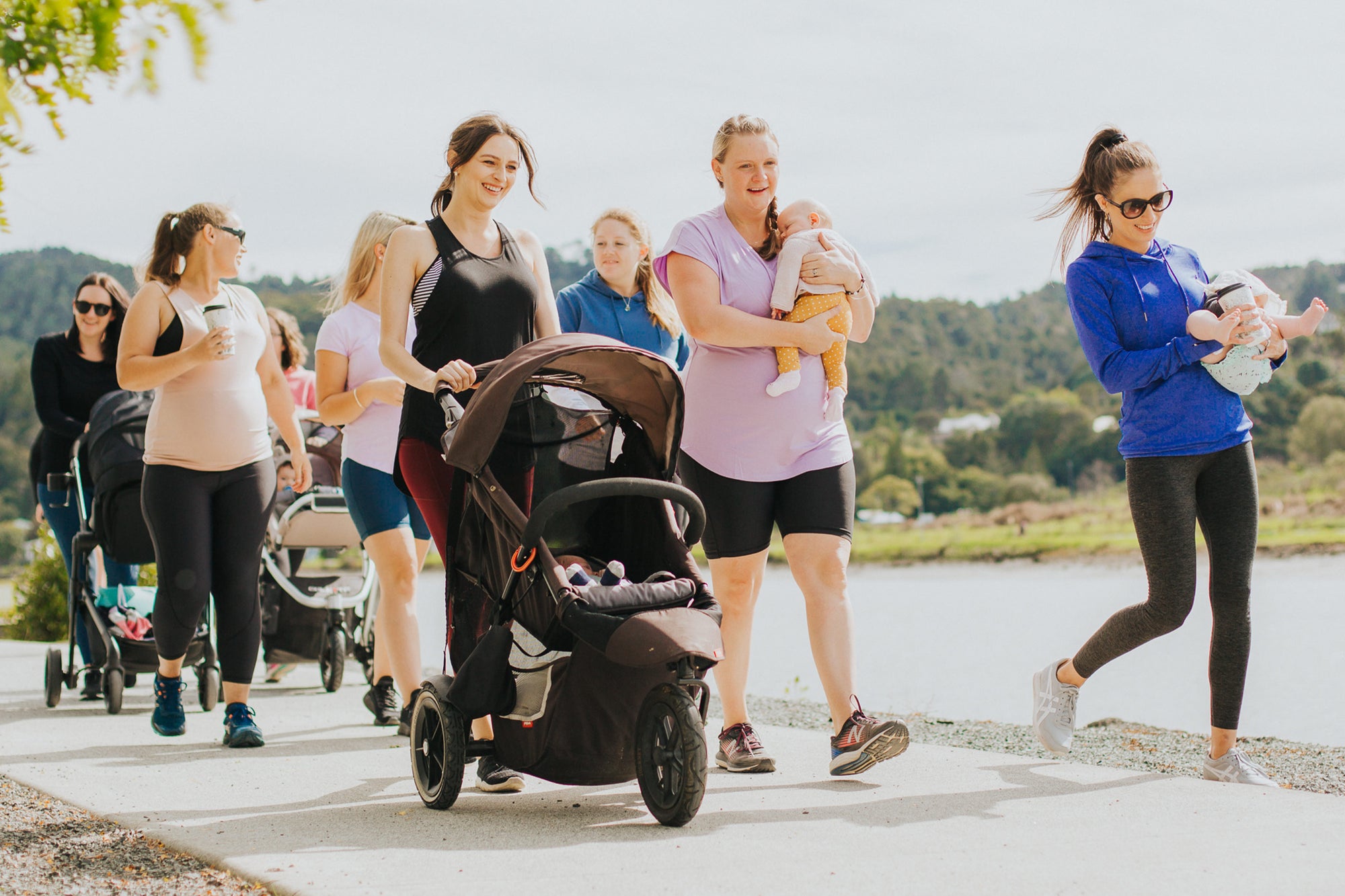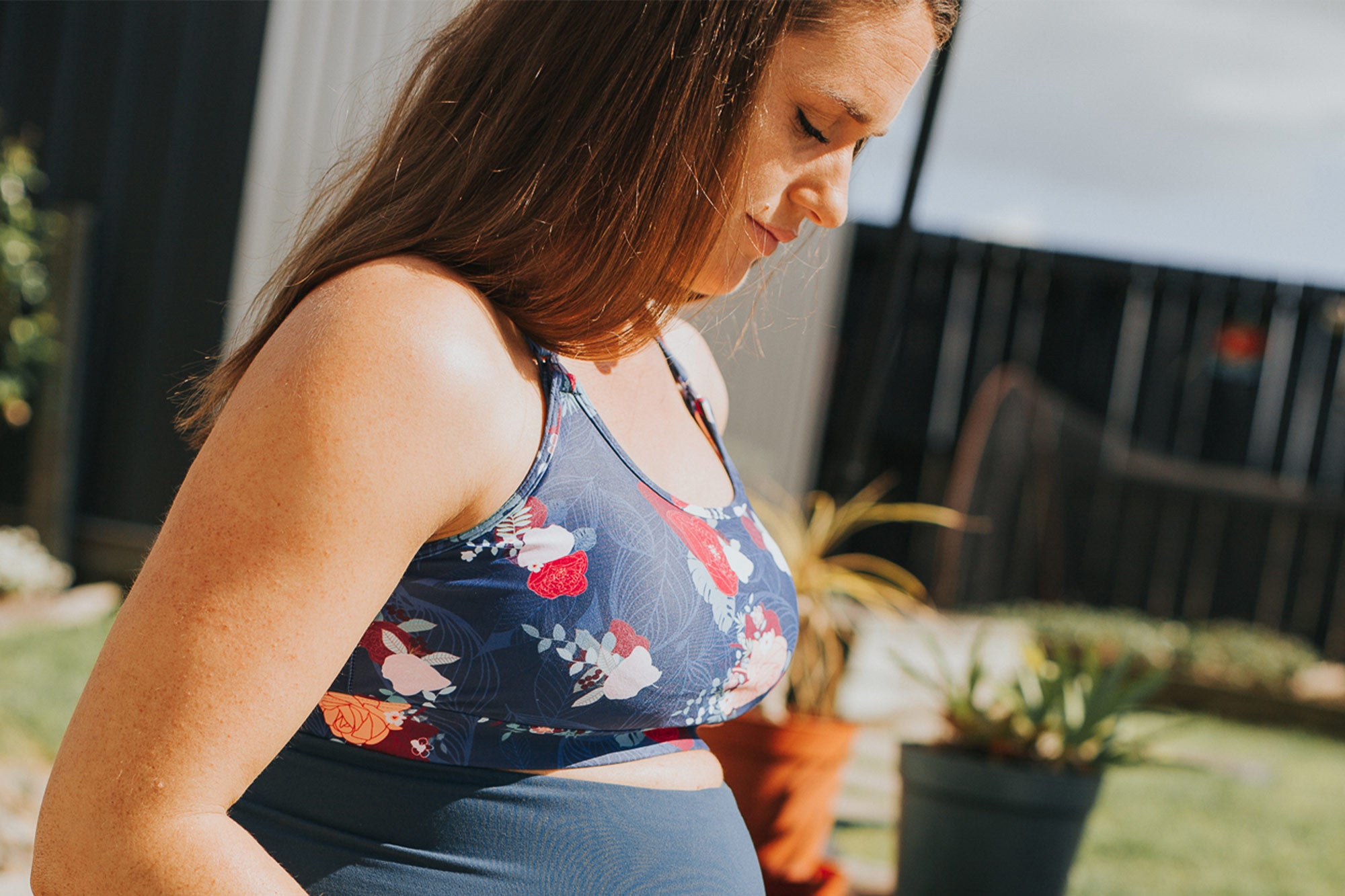Nikki C is reading up on how to use the 'BelleMa Effective Pro' breast pump, whilst wearing the 'Aspire Top' in neo.
When I had my first baby boy (Bede), I remember being quite excited about breastfeeding…sheesh, little did I know!
Don’t get me wrong, overall I was one of the lucky ones and had a great experience - I had a good supply, Bede latched on well…BUT I did have an inverted nipple (TMI?) so the wee fella had to work super hard on one side until it ‘popped out.’ Should I be telling you this? Oh whatever…they’re just boobs! Anyway, it took about two weeks for me to stop gritting my teeth and quietly cursing, ‘!@#$ !@#$ !@#$’ every time he latched on. Golly gosh it hurt. I’d had a vaginal delivery and a second-degree tear, but that wasn’t my concern, that paled in comparison…all the focus was on my nips and stopping the pain!
They say breastfeeding if done properly ‘shouldn’t hurt,’ but come on...my nipples had never been sucked on for hours on end by a human before, it was always going to take a bit of getting used to. Right?!
I used Lansinoh ointment after every feed to help ease the tenderness, and I went through hydrogel breast discs like hot cakes (they were AMAZING). For my ‘weirdo’ inverted nipple (hey it’s my nipple I can call it what I want) I had to use a nipple shield for a few days as it was getting so ripped and raw and…well…you get the idea…it needed a rest.
Thankfully, after about two weeks of battling, I woke up one day and it just stopped hurting all of a sudden – HALLELUJAH! My breastfeeding journey was really positive after that…just a rocky start, which I gather is pretty normal.
At four weeks postpartum, I began to think about getting my son on the bottle as I’d heard the earlier you do it, the less fuss there would be in the future. Plus, it would allow a little bit of freedom.
I was all for a little bit of freedom!
I wanted to go to the supermarket on my own for 30m, and not be called by my husband in a frenzy because Bede was screaming for a feed!
I remember getting to this stage of my breastfeeding journey and thinking, ‘there’s so much to know!’ How many millilitres do I feed him? How do I sterilize properly? What teats should I use? How the heck does this pump work? How long can I freeze my milk for? What's the deal with formula?
So, to help inform our readers on the matter, once again, Cadenshae has picked the brain of our lovely lactation consultant friend - Julia Daly. Julia has all the tips and tricks on how to best express, bottle feed and store milk.
Oh, and if you intend on breastfeeding for seven years straight, that’s amazing, but just read this blog anyway – even the most dedicated breastfeeders seldom manage to do every single feed straight from the breast.
EXPRESSING TIPS:
 Nikki J is expressing with the 'Crane Rechargeable Double Electric' breast pump, while rocking her 'Cruise Long Sleeve Top' in tui blue and the 'Classic Maternity Leggings - Full Length' in black.
Nikki J is expressing with the 'Crane Rechargeable Double Electric' breast pump, while rocking her 'Cruise Long Sleeve Top' in tui blue and the 'Classic Maternity Leggings - Full Length' in black.
1. Lactation consultants recommend women do not start pumping until their milk supply has been fully established, so around four-six weeks postpartum.
2. There are three types of pumps available: hand (manual) pumps, single breast pumps (electric) and double breast pumps (electric). Every woman’s needs and preferences will be different. For those who only pump occasionally, a hand-pump will probably suffice. However for those mums who need to express more often, an electric pump is recommended. Single breast pumps are perfect for those who express regularly (a few times a week) and a double breast pump is recommended for those who pump continuously (around three times a day). Double breast pumps although a time saver, do come with a heftier price tag.
3. It’s important to follow the manufacturer’s directions regarding use, cleaning and sterilising. Have a good read before you’ve had your baby to familiarise yourself and get confident with the equipment.
4. Nipples should move freely in the breast pump shield, with little or none of the areola being pulled into the pump shield. The standard size shield is 24mm but if you find your nipple is not moving freely, look at getting a larger size.
5. Express until the flow is reduced to drops. For a single pump, this usually means around 10m per breast, and for a double pump, 10m all up.
6. Pumping in a sturdy nursing bra allows you to go hands-free! Check out Cadenshae’s Nursing & Hands Free Pumping Sports Bra so you can get on with other jobs while you’re self-milking!
7. If you’re trying to increase your supply, express straight after every feed.
WHAT TYPE OF BREAST PUMP SHOULD I PURCHASE?
There are various things you should consider before purchasing a pump:
1. Hand or manual pumps are intended for occasional use only. Hand pumps take longer to use and extended use can be painful.
2. Electric breast pumps are for more frequent use OR to increase supply.
3. If you have a premature baby it’s best to use an electric pump as a hand one will not be strong enough to build a good supply and again - they can cause discomfort.
4. It’s recommended to buy or hire a pump, rather than use a ‘hand me down,’ from a friend as the home sterilization process won’t kill all the bacteria, meaning you could pass staph/thrush etc. onto your baby. If you have no other option however, it's then recommended you buy new personal kits, which include tubing and bottles.
5. The type of breast pump you choose should be determined by how often you will use it, however a lot of the time this isn’t known until the baby arrives. It is best to seek expert breastfeeding advice before hiring or purchasing any breast pump equipment. You don’t want to make a costly mistake.
BOTTLE FEEDING TIPS:
 Michelle is bottle feeding her beautiful baby boy Charles in the 'Scoop Tee' in lilac.
Michelle is bottle feeding her beautiful baby boy Charles in the 'Scoop Tee' in lilac.
Bottle refusal is most likely to occur in babies who’ve been exclusively fed from the breast past six weeks of age, or given bottles prior to six weeks of age, but not consistently. The primitive sucking reflex weakens over time, reaching total extinction by four months old.
With that in mind, the recommendation is to introduce a bottle around four-six weeks of age, after this point, it becomes less likely a baby will accept a bottle. During this window, offer a bottle of expressed milk every couple of days. It doesn’t have to be a full feed; 30mls will be enough to develop the skill without replacing the feed.
Some babies accept a bottle without fuss, even when it’s introduced later than this, but to avoid the risk of adamant refusal, it’s highly recommended you start to offer a bottle at four weeks and continue to offer regularly from then on out.
If you’re struggling to bottle feed your baby, experiment with some of Julia’s expert tips:
1. To begin with, try freshly expressed milk so you know the milk is warm, fresh and tasty...thus increasing the chances of your baby accepting it.
2. Try different caregivers. Babies can get confused initially if Mum is giving them a bottle and not her breast.
3. Try different times of the day and different levels of hunger, i.e. the first feed of the day often works well.
4. Test out different bottles, different teat shapes, and different flow rates.
5. Sometimes it helps to attempt to match the teat to the breast ‘flow.’ If you have a fast let down, your baby may need a faster flow and thus teat. Slow flow teats are generally the best to start with though.
6. Don’t fight it! Keep practice playful and low stress. If your baby senses your anxiety they’ll be less inclined to feed.
7. Experiment with different positions: side lying or sitting up, standing up, bouncing, in the bathtub, in a carrier etc.
8. Offer the bottle before your baby is hungry (before they get grumpy)!
9. Introduce the bottle when he/she is calm, i.e. when she is just waking from a sleep, or is falling asleep.
10. Touch the bottle to the baby's lips and chin and wait for him/her to open their mouth. Go slowly with it, be patient, don’t force it in!
11. Let your baby suck for 30-60 seconds before tipping the milk into the teat.
12. If the baby is struggling, tip the bottle back so milk is no longer flowing and wait until he/she is ready to suck again.
13. Try leaving a shirt of yours near the person giving the bottle so it smells like, ‘Mum.’
14. Is the milk sour? Soapy? Maybe it’s been stored too long, and hasn't been kept cold? Smell it, taste it, look at it - you’ll know if it’s off.
BREAST MILK STORAGE GUIDELINES:
There are many different types of containers that can be used to store breast milk including breast milk storage bags, plastic bottles, glass containers, and breast milk trays. (Personally I like the storage bags as they can be spread flat to save space in my already chokka freezer)!
FORMULA:
At Cadenshae, obviously our upper body gear is designed to help women who are breastfeeding, however as a business, we don't buy into the whole 'breast is best' scenario. There can be so many complications involved when it comes to nursing that we know for many mamas, breastfeeding just isn't a viable option. With that in mind - we're all about 'fed is best.' You have got to do what is right for you and what is right for your baby. So, if you're looking or have already started formula feeding your baby, we only suggest four main things:
- Follow the instructions correctly.
- Steralize the bottles and teats etc. appropriately.
- Don't feed your child 'old' formula, always make up a new bottle for each feed.
- Find a formula that is quite plain with less 'stuff' in it. A hypoallergenic formula is a good one to use (try the Aptamil range). But hey...we understand babies can be fussy, so if you need to try a few out until they actually drink the stuff...then so be it.
And there you have it. We wont say it's all you'll ever need to know about the topic, but it's a very good start at least!
Remember, try not to get frustrated by the bottle-feeding process if it isn’t going too well. Your child will not let itself starve - scientific fact! You’ll get there, but if you are struggling, drop Julia a line - she’ll be able to help you!
You've totally got this mama!
Written by Ellen Chisholm in conjunction with International Board Certified Lactation Consultant - Julia Daly.




